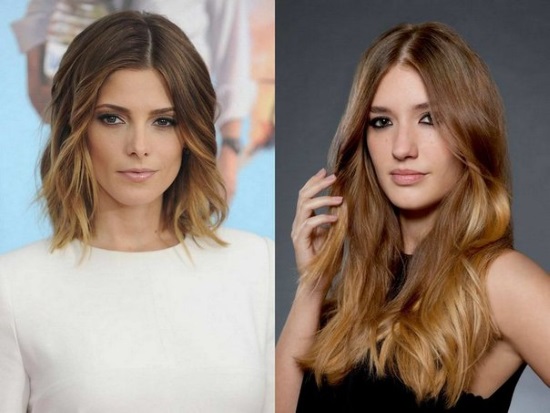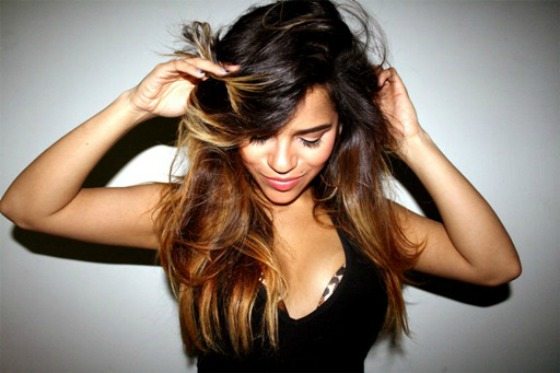
For several seasons in a row, ombre remains one of the most popular types hair coloring - gradient transition from dark roots An increasing number of fashionistas prefer lightened or tinted ends. Coloring, which looks like regrown or faded hair, is gaining more and more fans every year, and for good reason - this hairstyle allows you to add zest to the image without resorting to drastic coloring and without deteriorating the hair structure. The natural color of the roots can also be any, but the most interesting is gradient coloring that emphasizes brown and black hair. In the article we will talk about the features of this type of coloring for brunettes, consider the types of ombre and give tips on how to make ombre hair at home dark hair.
What types of ombre are there?
- Two-tone classic ombre. It is a two-tone coloring with a smooth transition. Dark strands dyed using this technique look very natural; the main color is shaded by strands of different shades.
- Multi-tone coloring. Unlike the classic version, this one involves the use of intermediate tones that create the effect of smooth transitions from roots to ends. To color dark hair, caramel, cognac, chestnut, coffee and gold shades are usually used.
- Horizontal ombre. Horizontal coloring represents a clear contrast between the roots and ends, without a smooth transition.
- Ombre with stripe. , in which a horizontal stripe of a contrasting shade is drawn down the center.
- . With this technique, either one shade or several colors can be used; before tinting, the ends are pre-lightened. As a rule, colored ombre is done on long hair. For black curls, a blue-violet color scheme is used; for chestnut and dark blond curls, cherry, fiery red and lingonberry tones are used.
- Monochrome ombre. One of the most stylish and unusual combinations blue-black with platinum blonde. Monochrome color transitions are made with both a clear and blurred border; coloring individual strands at the ends is also popular.
- Ombre effect. Gives strands a sun-bleached look, dark roots smoothly transition into lighter, armored ends. “Regrown roots” usually occupy from 8 to 20 centimeters, the transition line can be smooth or contrasting.
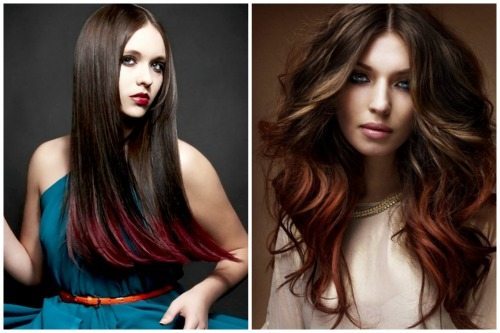
Benefits of ombre dyeing on dark hair
Why you should try ombre:
- It looks natural and at the same time very expressive;
- Does not require regular color updating and root painting; the hairstyle retains its appearance for a long time;
- You can use it to color both straight and curly hair;
- Using a combination of different tones when performing ombre on dark hair will add additional volume to the hairstyle;
- Suitable for ladies of any age;
- With this coloring you can soften sharp facial features, as well as visually “stretch” a round face;
- It looks very stylish and does not require complicated styling.
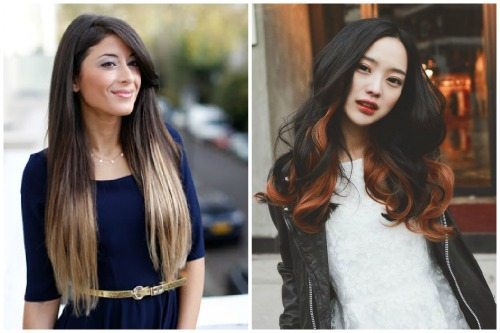
Is it possible to do ombre on dark hair yourself?
Do fashionable coloring this season is not that difficult. The diagram below shows how to paint yourself step by step without resorting to the services of professionals. For home coloring you will need:
- paint for painting and instructions for it;
- glass or plastic bowl;
- non-metallic comb for even application of paint;
- disposable gloves;
- hair bands;
- hairdressing brush;
- foil;
- hair balm;
- hair oil
- Mix the paint and oxidizer according to the instructions;
- Divide your hair into 3 equal strands.
- For a classic option, apply dye to the ends, starting with the front strands, then to the back. Make sure that the painted areas are located approximately at the same level;
- There is also an option when the curls are gathered into a ponytail and the paint is evenly distributed over the ends;
- For colored ombre, the ends are pre-lightened, after which dye is applied to them;
- Wrap the dyed strands in foil (you can also use cling film) and wait for the dye to take effect (time specified in the instructions);
- After time, wash off the dye and dry your hair with a hairdryer;
- To create a transition, apply paint to the place where the color transitions, a few centimeters above the painted area and hold for another 10 minutes;
- Rinse off the dye and use a balm to soften the strands;
- To make your hair shine and prevent breakage and split ends, lubricate the ends with special oil.
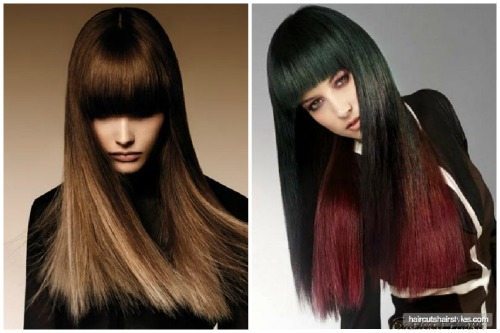
Ombre for dark long hair
Long hair gives a huge scope for imagination, because any method of coloring using the ombre technique will look advantageous on it, both light shading of the strands and bright contrasting combinations. Examples various options Ombre for long dark hair can be seen in the photo.
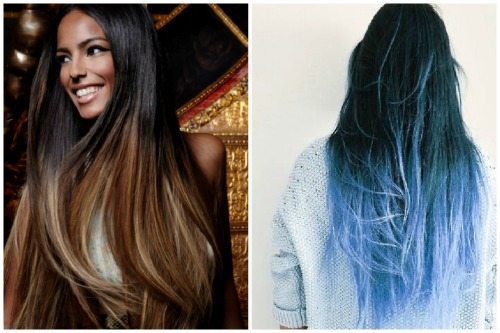
Ombre for dark medium hair
Ombre for dark hair medium length It is preferable to do it using the multi-tone coloring technique with smooth shade transitions. To create the effect of slightly grown roots, ombre on dark medium hair is often done by backcombing at the roots. Examples of various ombre options for brunettes with medium hair can be seen in the photo.

Ombre for dark short hair
If you have or, ombre on short dark hair will look unusual and expressive. It is better to choose coloring options when the bangs and ends of the face are highlighted with the help of colored strokes. You can also experiment with bangs by coloring them using the ombre color technique, or vice versa, using delicate natural tones. It is better to use smooth transitions between colors; the contrast here will look ridiculous. Examples of various ombre options for dark short hair can be seen in the photo.
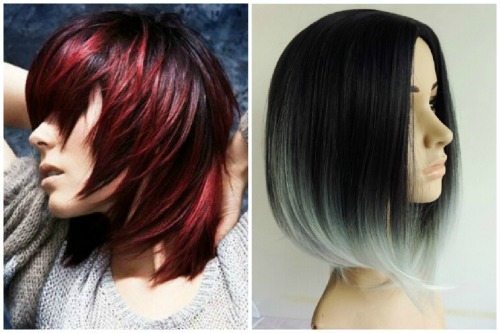
How to care for colored hair?
Lightened and colored hair needs especially careful care, so it is better to use special nourishing products that restore the hair structure. It is advisable that shampoo, conditioner, and masks contain olive or avocado oil. Try to reduce the use of curling irons to a minimum; use for curling.
Fashion never tires of delighting us with new original techniques. Among the latest innovations, ombre coloring deserves special attention, which has already been appreciated by both world celebrities and many fashionistas. This technique of painting in 2 shades is still very young, but it is already breaking all records of popularity! Let's find out what is its difference from other two-color dyeing methods and how to make ombre on dark hair at home.
What is ombre: difference from other techniques
Ombre is the coloring of only the ends of the hair, starting from the middle. The effect of sun-bleached strands with a smooth or sharp change in color is created. Ombre dyeing for dark hair involves a transition from naturally dark to light. And on the strands, on the contrary, from light at the roots to dark ends.
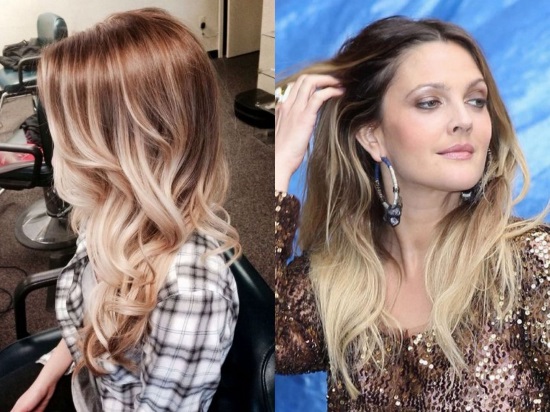
Sometimes ombre is confused with other types of coloring: degradation, balayage, highlighting, etc. Unlike degrade, it has a sharper color transition in the middle of the length, and degrade is a very smooth stretching of shades. Balayage involves coloring only the very ends and is performed on ponytails tied with an elastic band. Unlike vertical ombre on dark hair, it has a horizontal orientation. Well, bronding is multi-color highlighting.
This technique is also called the "regrowth effect". Moreover, they have grown a lot, but surprisingly everything looks very neat and stylish.
Who is suitable for ombre and what type to choose for dark hair
The color transition looks very stylish, adds volume to the hairstyle and does not require complex styling. Looks amazing both straight and on curly hair ah any length. You can create a beautiful ombre on dark hair both at home and in the salon, while the frequency of dyeing is significantly reduced. It is enough to perform an ombre on medium or short hair once every two to three months, and on long hair – once every six months. The growing strands will be invisible and natural.
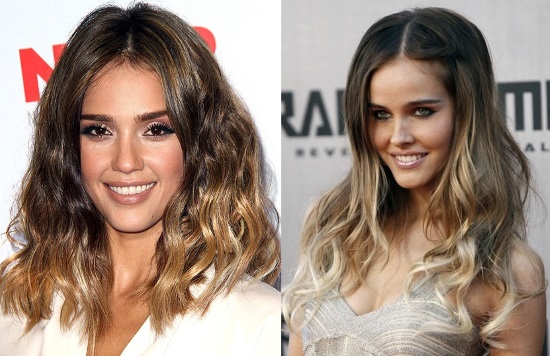
This coloring is ideal for those who want to maintain their own color by lightening only the ends. This is also an excellent solution for pregnant women and those who do not want to apply paint to the roots for some reason (skin sensitivity, itching, damage). Using a color transition, you can even correct the oval of your face. Lighter strands framing the face will help visually elongate the round shape, making full face thinner.
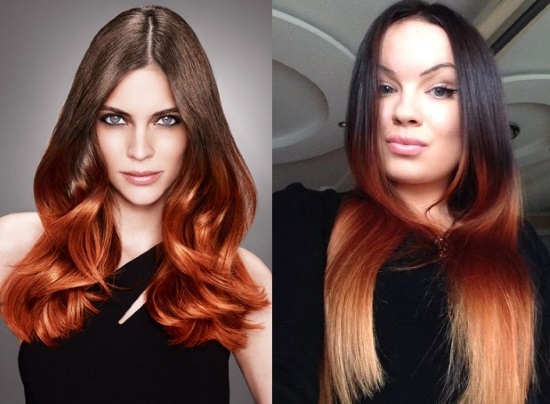
There are several types of ombre technique for dark shades hair done at home or in the salon:
- Classic - painting only the ends in a light shade.
- The opposite is true - the roots are painted in a light tone, the ends - in a dark tone.
- Colored - with this type of ombre, dark hair is dyed in bright or pastel shades at the ends.
- Sharp – a clear transition between colors.
- With bangs - on dark hair with bangs, ombre is performed at its ends or left natural.

Choosing paint and a suitable shade
If you decide to do everything yourself, then you will need a special paint with a comb. You can also do ombre at home with regular paint, but there is a risk of choosing the wrong tone or getting an uneven transition.
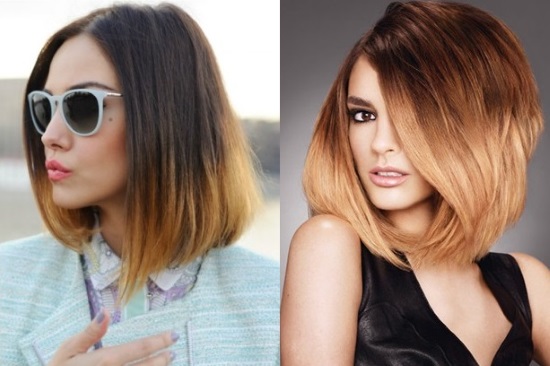
Today you can easily find special sets from the brand. On at the moment This is the only brand that produces ombre dyes and materials for dark hair for home use. But if you don’t like these sets, you can use any other paint in combination with a special comb or do without it altogether. We will talk about this trick below.

For now, let's choose a color. L'Oreal Ombre is available in 5 tones: for dark and light chestnut shades; for chestnut and dark blond; for fair-haired people who are transitioning to blond. And also copper-red and red ombre for dark brown and light brown hair.

If you choose a different paint, pay attention to the color compatibility:
- On black hair, the ends are lightened to a light chestnut or caramel shade. Colored tips will look impressive.
- Golden, caramel, copper and honey tips work well with chestnut curls.
- On medium and dark brown hair, you can use the lightest shades from wheat to platinum for ombre.
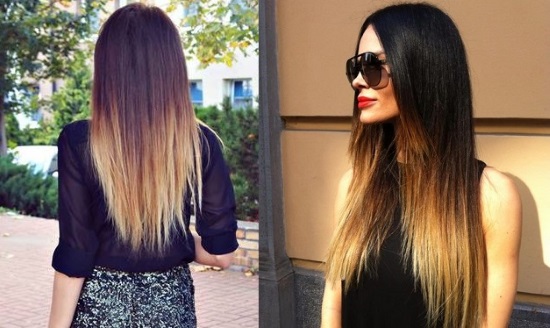
Coloring technology using the L'Oreal kit
If you choose a ready-made kit, then dyeing your hair will be very simple. So, how to do ombre on dark hair:
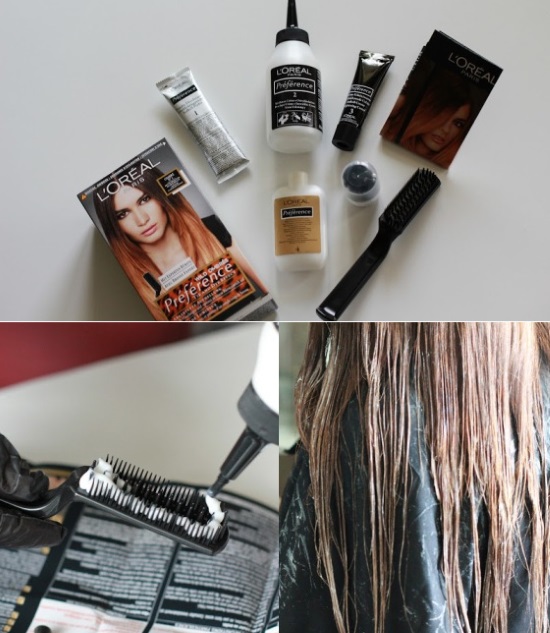
- Prepare for the procedure - cover your shoulders with a peignoir or towel, put on gloves.
- Mix all paint components in an applicator bottle and shake thoroughly.
- Section dry hair into large sections for ease.
- Squeeze out a little coloring mixture onto a special comb.
- Using a comb, apply the dye to the strand, starting from the earlobe to the ends. Special teeth of the comb will help to distribute the composition correctly.
- To achieve a smooth transition, hold the brush vertically, and horizontally for a clear border. Pass through the strands only once.
- Depending on the desired result, leave the product on for 25 to 45 minutes.
- Wash off with shampoo.
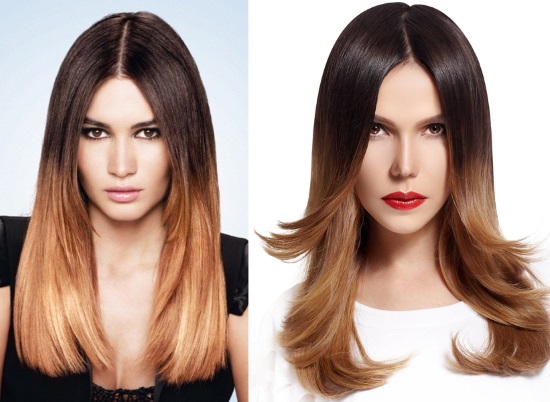
You can make ombre at home without L'Oreal paint, using any other paint. To do this:
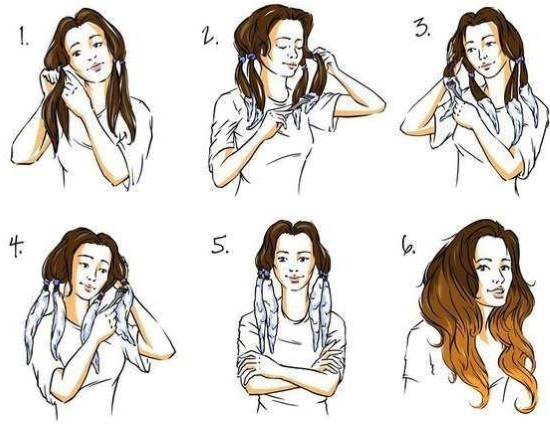
- Mix paint and developer in a non-metallic bowl according to instructions.
- Tie 4 low ponytails at the earlobe area.
- Apply the paint with a brush below the elastic; for a stronger lightening, wrap the ponytails in foil.
- Let stand for about 30 minutes, remove the foil, loosen the tails.
- Now apply paint with a brush 3-5 cm above the level where the rubber bands were. Comb your hair with a plastic comb from this line to smooth out the color transition.
- Leave the paint on for about 10 more minutes. Total time exposure should not exceed the time specified in the instructions.
- Rinse thoroughly.

If you like photos of bright ombre on dark hair, then after lightening the ends, tint them with washable tint products or tinting dyes.

One of the varieties of the popular “shadow” coloring is red ombre. It gained popularity on both sides of the ocean, but appeared, of course, in California, where the hair of glamorous surfers was actively fading in the sun.
Classic monocolor tinting has long been losing its position. Instead, several types of gradient coloring were gradually introduced into our lives, including black-red ombre on hair. Vanessa Hudgens, Amber Le Bon and Alexandra Burke did not ignore this trend at one time. In this article we will tell you in what variations red ombre exists, and how to create this miracle at home.
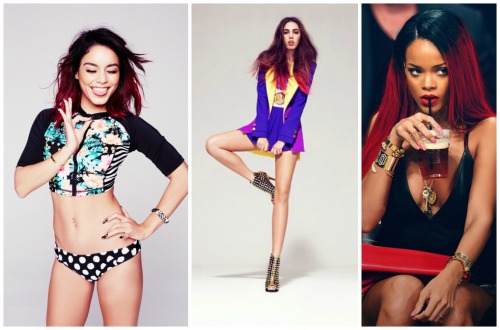
Benefits of red ombre
Why is red ombre on black hair a great choice for girls whose locks are naturally a rich dark shade?
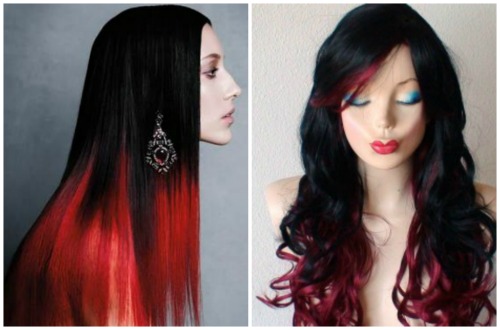
- Firstly, because they won’t have to radically change the color of their entire hair, or dye individual strands along the entire length. It is enough to slightly lighten and delicately tint the strands by a third of the length - just that part that will eventually have to be cut anyway;
- Secondly, like any imitation of natural burnout, dark red ombre is guaranteed to give natural volume to the haircut. The curls will not look boring and dull, and their owner will receive a boost of energy from the attention of others. AND good mood as a result of change for the better;
- And thirdly, with the help of this type of tinting it is possible to correct the problematic oval of the face, focus on its bright features and divert attention from shortcomings. For example, you can visually elongate a round face if you apply diagonal ombre coloring on red hair.
- In addition, this procedure can be performed not only on black hair: red ombre is also quite popular on light strands. The length is also not of fundamental importance: a red ombre on short hair can look just as successful and appropriate as on strands that reach the middle of the back.
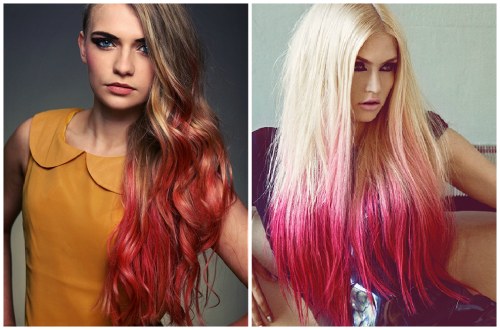
Classic: red ombre on dark hair
Red ombre on dark hair has become a kind of standard for this fashion trend. It is with its help that the most vivid, shocking images are created (as we see in famous photo Jessie J is a fiery brunette with scarlet ends of her long silky strands).

- It should be borne in mind that a red ombre on dark hair is not a solution for the timid. After all, bright scarlet, fire orange, raspberry and fuchsia are guaranteed to attract attention to your person. And it is not always benevolent: there will always be conservatives in society who are opposed to an extraordinary hairstyle.
- However, there is an undeniable plus: a girl with chic iridescent hair will not get lost in any crowd (even the most informal and unbridled).
- An emphasis on the face is automatically achieved: after all, the color border is most often located between the cheekbones and chin.
- If you choose to dye your hair ombre red, you need to be prepared for difficulties. It is quite difficult to lighten the ends the first time so that bright paint lay on them evenly, and the color was not distorted. Here you need to find the optimal balance between price and quality: only a high-class professional can achieve the desired effect without damaging the hair texture. But the services of such a stylist are often not cheap at all.
- One of the most available ways to get the effect of a crimson rainbow on black hair - use or special ones. Today, these products are widely available in cosmetic stores. One catch - this coloring is short-lived: until the first wash.
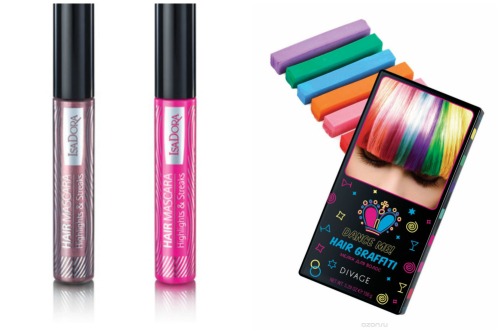
Alternative: red ombre on blonde hair
For those who have decided to change the style of Christina Aguilera, red ombre on blonde hair is suitable. It does not require preliminary preparation or lightening of the strands: the dye is applied directly to the ends of blond hair.
- It is better to choose high-quality and delicate paint, but at the same time resistant to washing off. Regarding color palette, then there is plenty to choose from. Raspberry, hot pink, lilac and copper red are all colors that will suit the fair skin of natural blondes.
- Red ombre for blonde hair is a great choice for your imagination. The main thing is to clearly understand what you want to get in the end. The ideal ombre for blonde hair is a stretched transition of color, as seen in photos of celebrities who have chosen this style (for example, the beauty Dakota Fanning with her experiment in peach color).

How to make your own red ombre
This part of the article is for those who do not give in to difficulties. And also for those who have long been their own stylist. Indeed, hardly anyone knows the characteristics of our hair better than ourselves.
We'll tell you how to do it in red yourself. This scheme is not particularly complicated and consists of several steps:
- The day before, before coloring yourself, a nourishing and moisturizing mask made from vegetable oil will not be superfluous. It can be left on washed hair overnight;
- After this, you will need to lighten about a third of the length of your hair. The ends are treated with a clarifier, which must be applied for a strictly specified time by the manufacturer;
- It’s time to wash the colored strands thoroughly, then apply the final paint (for example, bright red), and use a brush to “stretch” the color border vertically;
- The last step after removing the dye is to use a restoring balm. If you skip this point, the curls may become brittle and excessively dry, which will not decorate their owner.
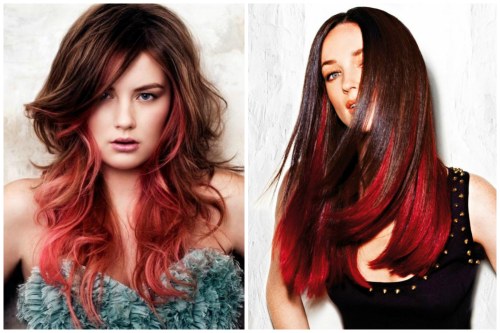
Red ombre: secrets of stylists
For those who want to get the perfect gradient effect without leaving the comfort of their hole, here are tips from professionals in the field: how to create a high-quality red ombre on your hair. We recommend that you study them step by step and carefully before embarking on exciting experiments with your hair.
- Tip 1: It is good to stretch the color using a toothed comb: it is used to distribute the paint vertically so that a clear transition of shades is not noticeable.
- Tip 2: Define boundaries. In order for the coloring to turn out no worse than the salon one, it is important to stylistically correctly outline the boundaries of red. On long hair this is the chin, and on medium length strands the stretch comes from the middle of the ears.
- Tip 3: To paint the back of your head with high quality and beauty, you should pull the strands forward, first dividing them into a straight parting at the back.

Instructions from professionals say that great attention should be paid to the choice of paint. So, the trusted and recognized manufacturer L'Oreal has a special line of products - Preference Ombre. It also contains our favorite red color. And to get a flawless red ombre on black hair, there is a convenient comb included, and even a special nourishing shampoo for a safe procedure and beautiful shine.
Video: Red ombre at home
Most of today's women prefer to dye their strands using a soft and gentle method, so as not to harm them. Ombre for blonde hair is just what you need! It is completely safe, it does female image light and emphasizes all the advantages of the face.
Benefits of ombre
Ombre painting is perfect for those who want to change something, but not radically. This technique has a lot of significant advantages:
- Saves natural shade– after all, you will have to paint either the ends or the roots;
- Ombre can lengthen an overly round face. It is enough to lighten the strands on the sides a little more;
- With this method of coloring, you can forget about visiting the salon for the next six months, because the growing roots look very natural;
- If the paint is applied only to the ends of the strands, the roots will remain healthy;
- Ombre on medium hair gives expressiveness to the look and emphasizes facial features;
- Dyed ends can be easily trimmed without much harm to the overall length of the hair;
- Classic ombre involves changing the color by only 1-2 tones, so after it you can easily return to your natural shade.
Types of ombre for blondes
Ombre coloring for blonde hair comes in several forms. Let's look at each of them.
Classic
Here they use two colors with a soft and smooth transition. The roots are painted natural, and the ends are painted lighter so that they are different, but look natural. The effect is of burnt strands. In classic ombre, a natural tone is used - light brown, beige, coffee, copper, chocolate, honey or amber.


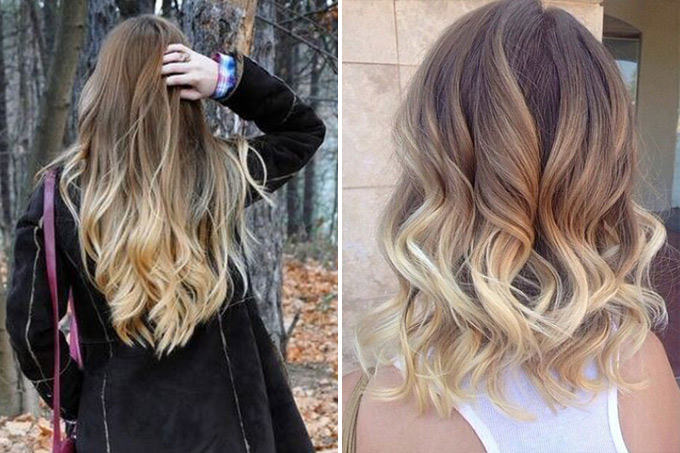
The effect of regrown roots
Implies a transition from dark to light shades. The border of such transitions is most often made in the area of the cheekbones or temples.

Dyeing bangs
It is also called one of the types of ombre. Along with the bangs, the framing strands are often dyed.
Triple
In this case, the ends and roots of the hair are dyed one color, and a horizontal strip of a completely different shade is passed between them. Its boundaries are blurred, so the result looks very natural.
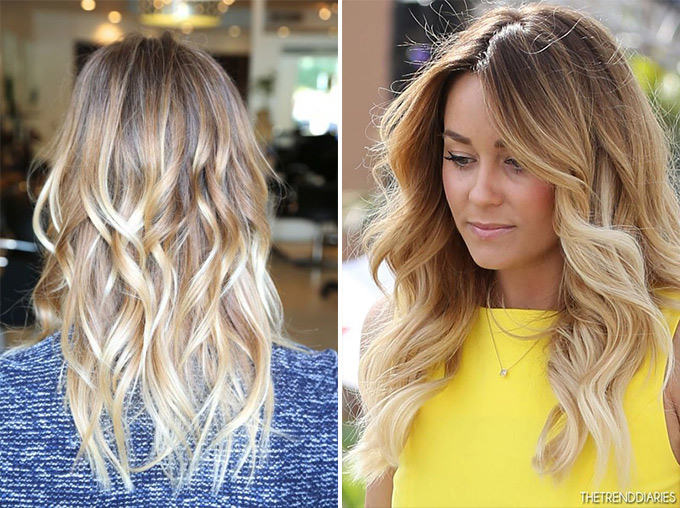
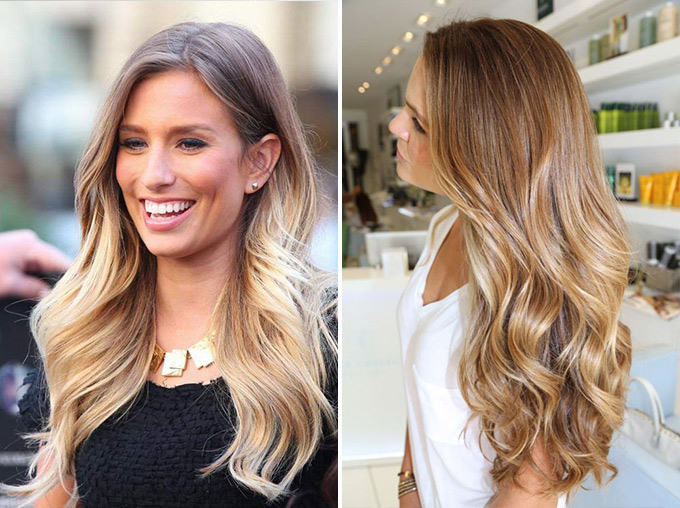
Colored or DipDyeHair
For it you need to choose a bright and contrasting color - blue, pink, green, pink or blue. You can dye both roots and ends. This look is suitable for extraordinary people, but it is better for strict and businesslike people to avoid it.
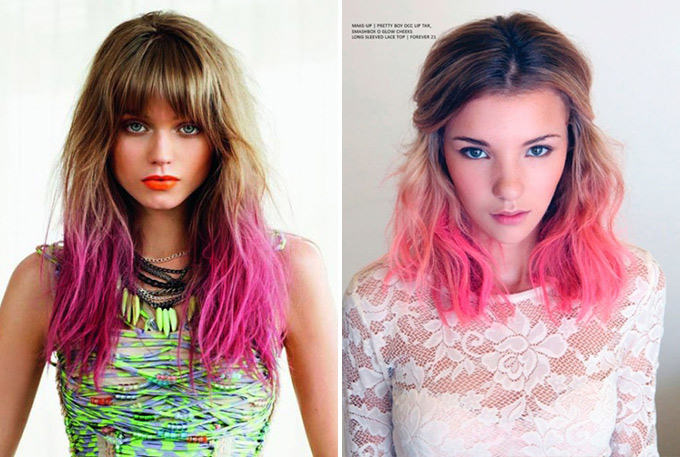

Reverse
With this type of ombre, the roots are made lighter or lighter in tone, and the ends are given a darker shade - dark chocolate, brown, chestnut, milk chocolate, caramel. The border should be soft, although recent seasons contrasting transitions are gaining popularity. This stretch of color gives volume to the strands and creates a bright image.
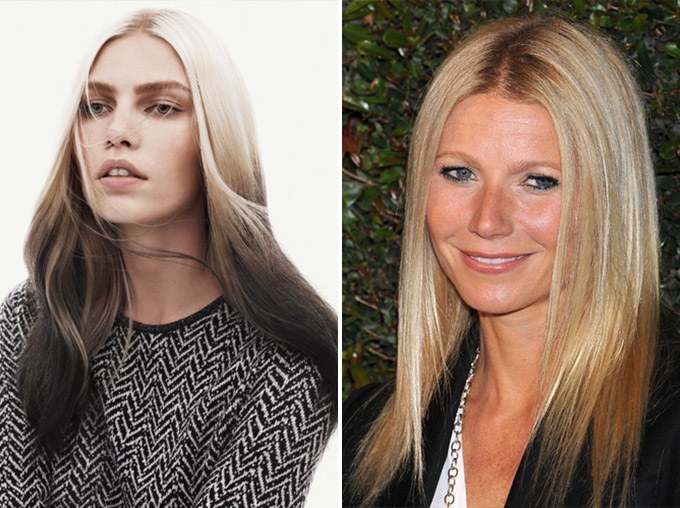
Important tip from the editor
If you want to improve the condition of your hair, special attention It’s worth paying attention to the shampoos and conditioners you use. A frightening figure - 96% of shampoos from popular brands contain components that poison our body. The main substances that cause all the troubles are designated on the labels as sodium lauryl sulfate, sodium laureth sulfate, coco sulfate, PEG. These chemical components destroy the structure of the curls, the hair becomes brittle, loses elasticity and strength, and the color fades. But the worst thing is that this nasty stuff gets into the liver, heart, lungs, accumulates in organs and can cause cancer.
We advise you not to use products that contain this chemical. Recently, experts from our editorial team conducted an analysis of sulfate-free shampoos, where products from Mulsan Cosmetic took first place. The only manufacturer of completely natural cosmetics. All products are manufactured under strict quality control and certification systems. We recommend visiting the official online store mulsan.ru. If you doubt the naturalness of your cosmetics, check the expiration date; it should not exceed one year of storage.
Face shape and ombre
When you decide to make an ombre, determine your face type and choose the right tone accordingly:
- Light shades will help make the square more subtle, while dark colors make it heavy;
- Warm tones are suitable for a triangular face;
- For those with round faces, we recommend a gradient from dark roots to lighter ends. This will elongate the face;
- But for long faces, it is better to choose an ombre that is 2-3 tones lighter than the natural shade;
- At diamond type face, color the strands on your face in a more dark colors– they will be able to soften the cheekbones;
- For a trapezoidal shape, when the lower part is wider, it is better to lighten the roots.
Home beauty salon, or how to do ombre?
The technique of performing ombre at home takes place in several stages.
Stage one. Hair lightening
- Divide your hair into 4 equal parts using a cross parting at the crown. If your hair is thick, you can divide it further. Each of these parts must be secured with a hairpin.
- Dilute the clarifier - powder and oxidizing agent 1:1.
- Apply it to the strands from about the middle. After waiting the time indicated on the package, rinse off the product with warm water.
Stage two. Toning
- Comb the damp strands and separate them from the right to the left ear.
- Prepare a toner.
- Starting from the back of the head, separate a strand of hair (2 cm wide) and place it on foil.
- Apply paint to the strands, moving the brush from top to bottom.
- Cover the painted part with a second piece of foil.
- In the same way, process the entire hair below.
- Divide the hair at the front in half using a straight parting.
- Take a strand 2 cm wide at your temple and place it on foil.
- Paint it and cover it with a second piece of foil.
- Work through all the strands at the front of your head.
- After 20-30 minutes, wash your hair with water and balm. There shouldn't be any shampoo.
When choosing a tinting paint, remember that a permanent dye will last for a month and a half, and a temporary dye will be washed off after the fifth wash.
After dyeing your strands, avoid shampoos that contain sulfates - they wash out the dye. Take hair care vitamins regularly. They will protect your hair from falling out, drying out and breaking off. To fashionable hairstyle held on as long as possible, it is recommended to wash your hair no more than 2 times a week.
You might be interested in:
Fashionable balayage coloring: trend 2016
Ombre for blonde hair will make you the most beautiful. The main thing is to remember a couple of very useful tips:
- It is more difficult to achieve natural shades on light strands than on dark hair, so don’t be too lazy to go to a good salon. If you decide to perform this procedure yourself, be very careful and strictly follow the instructions;
- When dyeing your hair, choose a shade that is very similar to your natural color. With this solution, the growing roots are not so noticeable;
- Ombre looks great on curly hair. A spray with sea salt. Apply it to damp hair and let it dry completely - it will start to curl a little. You can use a curling iron, curlers or iron;
- For long and medium hair, it is recommended to make a cascade - with such a haircut, any ombre looks ideal;
- If you have a bob, you can make a transition from dark to light shades.
Ombre is a French word that literally translates to “shadow” or “darkening.” This dyeing technique appeared as an independent trend not so long ago, because just a few years ago, regrown dyed hair was considered bad manners. IN lately naturalness has become a trend, and ombre has gained enormous popularity. As a sample, we took surfers from California and Australia, whose hair on their heads burns out from time to time. But maybe this is just a beautiful myth.
Ombre technology emerged from several coloring techniques: highlighting, coloring and bronding. Directly performing shadow dyeing is a very difficult process, because hair is easy to spoil. The colorist applies dye only to part of the hair and stretches this area, resulting in an interesting effect - the color moves from one shade to another. And it looks very impressive.
Pros and cons of ombre
Any coloring is a big stress for a woman, because it is difficult to change her image. Ombre has a number of advantages that can be decisive in your decision about.
- there is no strong negative phenomenon, unlike completely painting the head;
- you can choose a soft transition from one shade to another;
- Ombre can be done both on already colored hair and on natural hair;
- transition effect colors will suit both a young girl and a mature woman;
- you don’t need to constantly touch up your hair; even grown-out curls will look impressive;
- if you are not satisfied with the hair coloring, then the ends can be cut at any time;
- partial coloring helps to correct the shape of the face, you just need to choose the desired shade;
- brittle and thin hair Ombre will help visually add volume.

However, despite this large number positive aspects, this technology also has negative nuances:
- Coloring may require several treatments, since the pigments of dark hair are resistant to dyeing;
- you should choose your colorist carefully– it is very difficult to achieve a smooth color transition;
- Before doing an ombre, you should make sure that the ends are not loose. Do not lighten brittle and weak hair;
- high cost of the procedure– this technology costs significantly more than conventional painting, and the prices for paint are also quite high.
Features of color selection
It is believed that ombre can be done on hair of any length. At the same time, short hairstyles require a more delicate procedure, because such ends cannot be cut off if unsuccessful. Yes, and working with short hair thinner.
To be sure of the success of coloring, it is best to contact a competent specialist. Doing ombre at home is not recommended.
When choosing shades, you should rely on your taste and some rules:
- If your hair is short, then you can make a transition with no more than three shades. After all, you can’t overdo it here; at the same time, a smooth transition is necessary.
- There are several transition options– a smooth transition from one tone to another, a sharp transition and the use of two artificial colors.
- In addition, according to color composition It is customary to distinguish two types of ombre– classic (smooth transition from dark to light or vice versa), and also – additional shades are used and the transition itself becomes very smooth. In the second case, it is important that a competent master does it. Not every colorist can achieve smooth colors even with two tones.
When choosing an ombre color for dark hair, it is important to choose a dye that is several tones lighter than your hair. Ideally, very cool shades should be used.
If you choose a color close to natural, the transition will be noticeable only in certain lighting and head angle. And if you decide to change dramatically, then you can try extravagant colors - crimson or pink. True, in this case the transition begins from the temples.
 Cool coloring
Cool coloring Dyeing technology
Consists of the following steps:
- Hair is not separated by several visual zones. A so-called “diamond” of individual strands is collected at the back of the head - this is what allows you to achieve the most natural effect;
- Pre-collected strands on the top of the head are braided into a ponytail. They are not touched during the entire work. After this, the master carefully combs the curls to the maximum lightening zone. Typically, a wool brush or fine-tooth comb is used;
- Only after such preparation can you proceed directly to the coloring itself. The process itself takes place in stages, and the darker the client’s hair, the more dyes will be used when dyeing. Using a brush, paint is applied to the surface of the strands. For especially dark hair, you will first need to wash off the color, and only then apply the coloring component;
- Next, the paint is washed off and tonic is applied - the next layer of pigment for bleaching. In order to achieve a beautiful and even ombre, all strands that differ in color are tinted separately. The process is labor-intensive, but it is important for the final result;
- When the desired result is achieved, all coloring and pigmented substances are thoroughly washed off and the strands are styled.
A similar dyeing technology is applicable for both straight and curly hair. In addition, the process is the same for light hair - only different shades of paint are used.
Current options for dark hair
There are many ombre options, so any woman can choose her own style. Each of them is suitable for a specific face type and hair structure - this variability allows you to experiment with coloring depending on your desires.
Classic ombre
In this embodiment, the hair roots have natural color or as close to it as possible. And the strands and ends are several tones lighter. provides a soft transition between colors, which looks very natural. Its border is always located horizontally. This look is suitable for straight hair of almost any length.
 Classic
Classic Overgrown armoring
This look is not much different from the classic ombre. The only difference is that the color transition starts from the middle of the hair and smoothly flows to the ends. When applying, dyes similar to those used for armoring are often used. This option is ideal for hairstyles on long hair.
Ombre with stripe or three zones
This option is suitable for those who have decided to radically change their style. Coloring occurs in three zones - at the roots, in the middle and at the ends. This look is possible in two compositions - the hair at the roots and ends have the same color, and the middle of the hair is colored several tones darker. The second type - the root part and ends are painted in cool tones, while the middle remains light. This type of coloring requires very long hair, otherwise the transitions will be blurry. The ideal length is below the level of the shoulder blades.
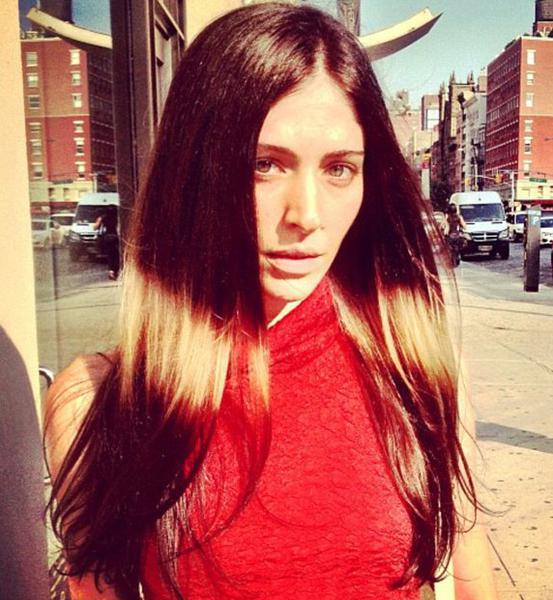 Coloring with stripe
Coloring with stripe Reverse ombre
The area at the roots is made lighter, and the entire lower part of the hairstyle remains in its natural color. It looks very unusual.
But you need to be very careful when choosing a dye - lightening your hair roots can result in big problems.
Color ombre
In this embodiment, we use bright colors for hair coloring – lilac, turquoise, red, etc. This look will look especially advantageous on women with rich complexions. natural color hair.
 Color option
Color option Contrasting ombre with a strong border
Sometimes it is also called shatush. Here, when painting, the emphasis is not on the smoothness of the transition, but on contrast and a sharp change in color. Lightening can be in the area of the ends or at the roots of the hair. As a result, your hair will look especially good loose, rather than tied into a ponytail.
Asymmetrical coloring
If you are not ready to make drastic changes and do a classic ombre, but want to look stylish, this look is especially suitable for you. Only part of the curls, which are located asymmetrically, are painted. After the procedure, the color looks very natural.
Glare
This type of ombre is devoid of bright colors, but at the same time natural and very expressive highlights are created on the hair.
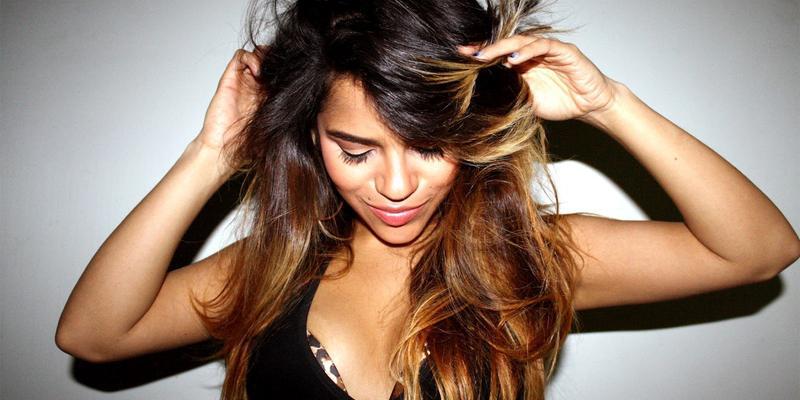 Glare technique
Glare technique The colors are selected in such a way that the transition is almost invisible. This allows you to give your hair volume and fullness.
Video
For an example of ombre dyeing on dark hair, see the video below.
Conclusion
Before you decide, you should consider all the pros and cons. And, of course, choose good master. Dyeing with this technique can be quickly corrected, but damage to the hair will still be caused. There are many examples on the Internet of how cool and stylish a smooth transition of colors looks, so every woman can choose something interesting for herself.

